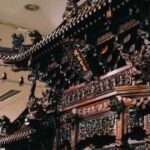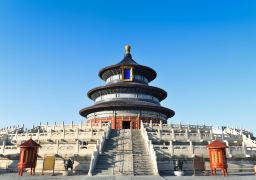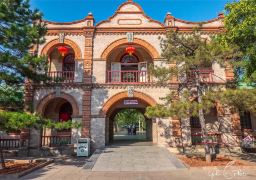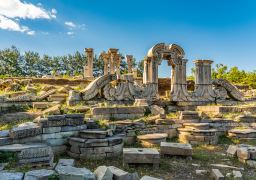‘Let us row the oars, the little boat pushes the waves…’. The place described in this familiar song is right here. Beihai is located on the northwest side of the Forbidden City and is collectively called the Three Seas together with Zhonghai and Nanhai. The park used to be an imperial garden. The pavilions and terraces in the garden are scattered and set off against each other. The trees by the lake are lush and the scenery is extremely beautiful.
Beihai has a long history of cultivating lotuses. As of now, Beihai Park has more than 100 lotus varieties and more than 1,200 pots of lotuses and various aquatic plants are maintained annually. From June to August, the early, middle and late lotuses compete with each other and bloom in succession. Highlights of visiting: This is also a park with the charm of old Beijing under the root of the imperial city. In the morning, old people will exercise and walk their birds here. In the afternoon and evening, it is more suitable for boating in the park. When you come to Beihai Park, you can admire the exquisite buildings left by the imperial dynasties. You can also sit by the lake and chat with the elderly around you. Listen to them tell the unofficial histories of the imperial families in Beijing and talk about those long-buried past events. Even more, you can blend into the crowd playing shuttlecock and diabolo and ask them for advice. Perhaps this is also a way to blend into the life of old Beijing. Overview of areas: Beihai Park takes Beihai as the center and is divided into four major areas: ‘North Shore Scenic Area’, ‘East Shore Scenic Area’, ‘Qiongdao Scenic Area’ and ‘Tuan City Scenic Area’. The north shore area is located in the northwest corner of the park. It is mainly composed of Kuai Xue Tang, Five-Dragon Pavilions, and Xiaoxitian, Jingxin Zhai, Chanfu Temple and Xitian Fanjing and a series of religious buildings. The well-known ‘Nine-Dragon Wall’ is also located in this area. The east shore area is located in the northeast corner of the park. It is mainly composed of Silkworm Shrine, Painted Boat Studio and Hao Pu Jian. The Qiongdao Scenic Area is located in the south of Beihai. With Yong’an Temple as the center, there are buildings such as corridors, Yilan Hall, Yuexin Hall and Yuedu Tower built around it. The White Pagoda, which has become the landmark building of Beihai, is located at the central high point of Qiongdao and has a majestic momentum dominating the whole park. Tuan City is located at the southern end of Beihai Park. The main building is Chengguang Hall. Inside the hall, there is a large jade Buddha 1. 5 meters high. The whole body is inlaid with gems and is dazzling. It must not be missed when visiting. The main scenic spots: The White Pagoda, located at a high place on Qionghua Island, is a Tibetan Buddhist pagoda. The tower is 36 meters high, with a round top and a square bottom. It is in the style of Mount Sumeru. The top of the tower is equipped with a precious cover and a precious top, and is decorated with patterns of the sun, the moon and flames to indicate that ‘Buddhism’ shines like the sun and the moon and shines on the earth forever. The White Pagoda stands on Qiongdao Island, surrounded by greenery. It is majestic and magnificent and can be called the symbol of Beihai Park. The Nine-Dragon Wall. There are three Nine-Dragon Walls in China. One of the more distinctive ones is this one in Beihai Park. The Nine-Dragon Wall is made entirely of colored glazed bricks. It is nearly 26 meters long and 6.65 meters high. It has a five-ridge and four-slope roof. Each side of the wall is decorated with nine coiled dragons. There are 32 dragons in total on both sides of the wall top and the wall.The coiled dragon playing with a pearl among the billowing waves and clouds has vivid modeling, gorgeous colors and superb craftsmanship. It is a fine work of glazed architecture in China. People come from all over to see it with their own eyes! Open hours throughout the year: From April 1 to October 31, open from 06:00 to 21:00; from November 1 to March 31, open from 06:30 to 20:00. Boat service stops at 16:00.
Preferential policies: Children: Free for those under 6 years old (inclusive) or under 1.2 meters in height (inclusive); on International Children’s Day (‘June 1’), one accompanying parent of preschool children under 14 years old (inclusive) can enjoy one free ticket. Minors: Half price for those aged from 6 years old (exclusive) to 18 years old (inclusive). Students: Half price for full-time undergraduate and below students (excluding adult education) with student ID cards. Elderly: Enter the park by swiping the ‘Beijing Tong – Elderly Care and Disability Assistance Card’; elderly visitors from other provinces and foreign countries aged 60 years old (inclusive) or above can enter the park by exchanging tickets with their ID cards, passports and other valid documents for free. Military personnel: Active-duty military personnel, disabled military personnel, retired military cadres, armed police officers and soldiers, and fire and rescue personnel can enter for free with their valid documents. Retired cadres: Free with retirement certificates. Disabled people: Free with disability certificates. Social security recipients: Those with social security benefit collection certificates enjoy half price. Service facilities: WIFI: Account: MyBeijing; Password: No password required; Coverage: Full coverage. Toilets: Available at the scenic spot ticket office and inside. Restaurants: Fangshan Restaurant, Qingfeng Steamed Bun Shop.








